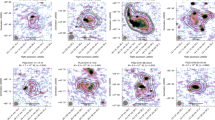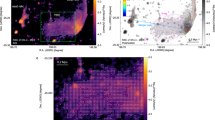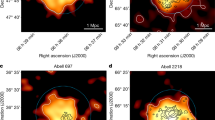Abstract
The amplitude of the magnetic field near the Galactic Centre has been uncertain by two orders of magnitude for several decades. On a scale of ∼100 parsecs (pc), fields of ∼1,000 microgauss (μG; refs 1–3) have been reported, implying a magnetic energy density more than 10,000 times stronger than typical for the Galaxy. Alternatively, the assumption of pressure equilibrium between the various phases of the Galactic Centre interstellar medium (including turbulent molecular gas, the contested4 ‘very hot’ plasma, and the magnetic field) suggests fields of ∼100 μG over ∼400 pc size scales5. Finally, assuming equipartition, fields of only ∼6 μG have been inferred from radio observations6 for 400 pc scales. Here we report a compilation of previous data that reveals a downward break in the region's non-thermal radio spectrum (attributable to a transition from bremsstrahlung to synchrotron cooling of the in situ cosmic-ray electron population). We show that the spectral break requires that the Galactic Centre field be at least ∼50 μG on 400 pc scales, lest the synchrotron-emitting electrons produce too much γ-ray emission, given other existing constraints7. Other considerations support a field of 100 μG, implying that over 10% of the Galaxy's magnetic energy is contained in only ≲0.05% of its volume.
This is a preview of subscription content, access via your institution
Access options
Subscribe to this journal
Receive 51 print issues and online access
$199.00 per year
only $3.90 per issue
Buy this article
- Purchase on Springer Link
- Instant access to full article PDF
Prices may be subject to local taxes which are calculated during checkout




Similar content being viewed by others
References
Yusef-Zadeh, F. & Morris, M. G0.18–0.04 — Interaction of thermal and nonthermal radio structures in the arc near the galactic center. Astron. J. 94, 1178–1184 (1987)
Morris, M. & Yusef-Zadeh, F. The thermal, arched filaments of the radio arc near the Galactic center — magnetohydrodynamic-induced ionization? Astrophys. J. 343, 703–712 (1989)
Morris, M. The Galactic centre magnetosphere. Preprint at 〈http://arXiv.org/abs/astro-ph/0701050〉 (2007)
Revnivtsev, M. et al. Discrete sources as the origin of the Galactic X-ray ridge emission. Nature 458, 1142–1144 (2009)
Spergel, D. N. & Blitz, L. Extreme gas pressures in the Galactic bulge. Nature 357, 665–667 (1992)
LaRosa, T. N. et al. Evidence of a weak Galactic Centre magnetic field from diffuse low-frequency nonthermal radio emission. Astrophys. J. 626, L23–L27 (2005)
Hunter, S. D. et al. EGRET observations of the diffuse gamma-ray emission from the Galactic plane. Astrophys. J. 481, 205–240 (1997)
F. A. et al. Discovery of very-high-energy γ-rays from the Galactic Centre ridge. Nature 439, 695–698 (2006)
Wommer, E., Melia, F. & Fatuzzo, M. Diffuse TeV emission at the Galactic Centre. Mon. Not. R. Astron. Soc. 387, 987–997 (2008)
Reich, W., Reich, P. & Fuerst, E. The Effelsberg 21 cm radio continuum survey of the Galactic plane between L = 357 deg and L = 95.5 deg. Astron. Astrophys. 83 (Suppl.). 539–568 (1990)
Reich, W., Fuerst, E., Steffen, P., Reif, K. & Haslam, C. G. T. A radio continuum survey of the Galactic Plane at 11 cm wavelength. I — The area L = 357.4 to 76 deg, B = -1.5 to +1.5 deg. Astron. Astrophys. 58 (Suppl.). 197–248 (1984)
Duncan, A. R. et al. A deep radio continuum survey of the southern Galactic plane at 2.4 GHz. Mon. Not. R. Astron. Soc. 277, 36–52 (1995)
Handa, T. et al. A radio continuum survey of the Galactic plane at 10 GHz. Proc. Astron. Soc. Jpn 39, 709–753 (1987)
Porter, T. A., Moskalenko, I. V. & Strong, A. W. Inverse Compton emission from galactic supernova remnants: effect of the interstellar radiation field. Astrophys. J. 648, L29–L32 (2006)
Atwood, W. B. et al. The Large Area Telescope on the Fermi Gamma-Ray Space Telescope Mission. Astrophys. J. 697, 1071–1102 (2009)
Koyama, K., Awaki, H., Kunieda, H., Takano, S. & Tawara, Y. Intense 6.7-keV iron line emission from the Galactic Centre. Nature 339, 603–605 (1989)
Thompson, T. A., Quataert, E., Waxman, E., Murray, N. & Martin, C. L. Magnetic fields in starburst galaxies and the origin of the FIR-radio correlation. Astrophys. J. 645, 186–198 (2006)
Voelk, H. J. The correlation between radio and far infrared emission for disk galaxies: a calorimeter theory. Astron. Astrophys. 218, 67–70 (1989)
Yun, M. S., Reddy, N. A. & Condon, J. J. Radio properties of infrared-selected galaxies in the IRAS 2 Jy sample. Astrophys. J. 554, 803–822 (2001)
Parker, E. N. The dynamical state of the interstellar gas and field. Astrophys. J. 145, 811–833 (1966)
Fukui, Y. et al. Molecular loops in the Galactic Center: evidence for magnetic flotation. Science 314, 106–109 (2006)
Crocker, R. M. et al. The cosmic ray distribution in Sagittarius B. Astrophys. J. 666, 934–948 (2007)
Yamauchi, S. et al. Optically thin hot plasma near the Galactic center — Mapping observations of the 6.7 keV iron line. Astrophys. J. 365, 532–538 (1990)
Güsten, R. & Philipp, S. D. in Proc. 4th Cologne-Bonn-Zermatt Symp. (eds Pfalzner, S., Kramer, C., Staubmeier, C. & Heithausen, A.) 253–263 (Springer Proceedings in Physics, Vol. 91, Springer, 2004)
Paglione, T. A. D., Jackson, J. M., Bolatto, A. D. & Heyer, M. H. Interpreting the HCN/CO intensity ratio in the Galactic Centre. Astrophys. J. 493, 680–693 (1998)
Ferrière, K., Gillard, W. & Jean, P. Spatial distribution of interstellar gas in the innermost 3 kpc of our galaxy. Astron. Astrophys. 467, 611–627 (2007)
Acknowledgements
R.M.C. thanks T. Porter for conversations about the Galactic Centre interstellar radiation field. D.I.J. thanks Monash University for hospitality. R.M.C. and D.I.J. thank J. Dickey for advice about radio data analysis. J.O. is a Jansky Fellow at NRAO; R.M.C. is a J. L. William Fellow at Monash University and a Marie Curie Fellow at Max-Planck-Institut für Kernphysik.
Author Contributions R.M.C. led the work and performed the main analysis. D.I.J. performed the analysis of radio data, including development of the Fourier-based technique for background and foreground removal, was responsible for original radio observations, and provided critical scientific discussion. F.M. provided input on theoretical and statistical problems, and critical discussion of scientific interpretation. J.O. supervised the analysis of archival radio data and the taking of original radio data, and provided input on statistics. R.J.P. provided input on thermal and relevant non-thermal processes and critical discussion of scientific interpretation. R.J.P. and R.M.C. provided supervision of D.I.J. as doctoral candidate. All authors discussed the results and commented on the manuscript.
Author information
Authors and Affiliations
Corresponding author
Supplementary information
Supplementary Information
This file contains Supplementary Notes, Supplementary Methods, Supplementary Table 1, Supplementary Figures S1-S8 with Legends, Supplementary Data and Supplementary References. (PDF 1768 kb)
Rights and permissions
About this article
Cite this article
Crocker, R., Jones, D., Melia, F. et al. A lower limit of 50 microgauss for the magnetic field near the Galactic Centre. Nature 463, 65–67 (2010). https://doi.org/10.1038/nature08635
Received:
Accepted:
Issue Date:
DOI: https://doi.org/10.1038/nature08635
This article is cited by
-
Fermi and eROSITA bubbles as relics of the past activity of the Galaxy’s central black hole
Nature Astronomy (2022)
-
High-Energy Particles and Radiation in Star-Forming Regions
Space Science Reviews (2020)
-
An X-ray chimney extending hundreds of parsecs above and below the Galactic Centre
Nature (2019)
-
Acceleration of petaelectronvolt protons in the Galactic Centre
Nature (2016)
-
Magnetic fields in spiral galaxies
The Astronomy and Astrophysics Review (2016)
Comments
By submitting a comment you agree to abide by our Terms and Community Guidelines. If you find something abusive or that does not comply with our terms or guidelines please flag it as inappropriate.



